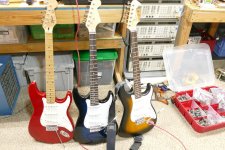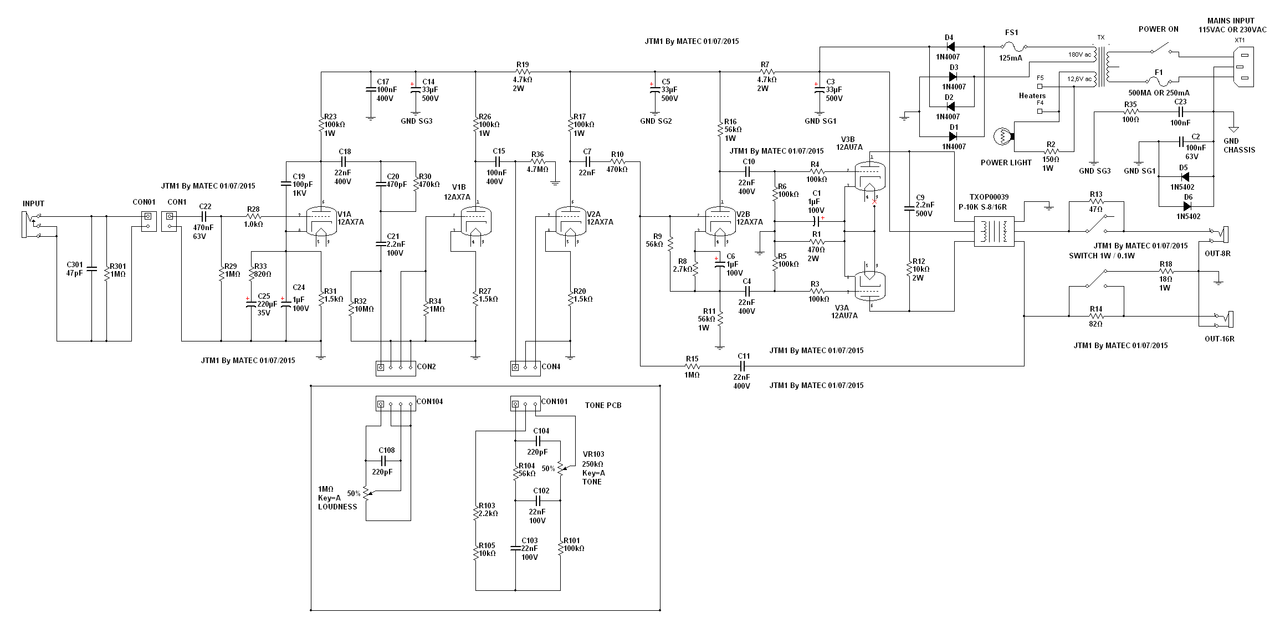Two observations, the 25L6 would be running a lower voltage where high gain amps usually run higher. Double the supply voltage would not be unreasonable. Did you pick the 25L6 because you have some of the bits and pieces or just by chance? The second thing is that building a high gain amp is not usually a beginner's project, especially piecing things together. It would be a better idea to use a design with a working layout. Maybe look at Ceriatone models and grab the preamp of one?
https://guitarampsusa.com/index.php?route=information/information&information_id=8
https://guitarampsusa.com/index.php?route=information/information&information_id=8
The 25L6 is a 6W6GT with a 25 volt heater. Some tubes are actually marked 25L6/25W6. The ratings for a 6W6GT do work for a 12L6, 25L6 and 50L6. The 35L6 is a different tube and will not live under long term use at high voltage. The 6W6 and its odd voltage cousins will live long and prosper with 340 volts on the plate as long as you keep the screen grid under 150 volts, preferably around 125 volts.
Some tubes will fail if run at the vertical sweep ratings with 300 volts in triode connection. The tubes will eventually go into red plate runaway if left to idle with no signal, as a vertical sweep system runs at full output all the time. Idle is worse case on the tube in any class A circuit since the tube must eat everything the power supply feeds it. When cranked, a good bit of that power gets turned into sound and the tube actually cools down.
Some tubes will fail if run at the vertical sweep ratings with 300 volts in triode connection. The tubes will eventually go into red plate runaway if left to idle with no signal, as a vertical sweep system runs at full output all the time. Idle is worse case on the tube in any class A circuit since the tube must eat everything the power supply feeds it. When cranked, a good bit of that power gets turned into sound and the tube actually cools down.
Yeah, I guess I forgot to state that I was squeezing 35 to 40 watts from a pair in push pull with UNSET technology. Apply feedback from plate to G1 and drive the cathode with a P-fet stood on its head. I can also get 20 watts from a pair of 50C5's too. In either case the idle current needs to be pretty low.Might be able to run high voltage on the plate but doing so would have you biased way off center unless I am missing something.
I haven't experimented much with SE yet, but the load impedance would probably be in the 5K+ range.
So far I have been in working at the other end of the power spectrum. Think Mega Fender Champ 5C1. Swap the 6V6 for a fat TV sweep tube and swap the 6SJ7 for a tiny 7 pin radio tube like a 6AU6, apply 500+ volts of B+. 20 watts at under 2% THD flows, so lets connect the guitar cable to the input with a pair of clip leads, and a 12 inch Eminence to the output, and turn the negative feedback completely off. It ROCKS. Two tubes and enough gain to get acoustic feedback with my new $119 Amazon / Fender Squire, the one on the right.
Two big sweep tubes get you 35 watts or one big fat transmitting tube (4D32) gets you 30 but looks way cooler.
I will explore the quieter end of the sound spectrum soon.
Attachments
Why not simply use the Fender "Champ" output, as on Robinette's site? https://robrobinette.com/How_Amps_Work.htm
Just put the circuit you posted with all the 12AX7 stages in front of the Champ output tube circuit. I mean, that should do just what you want!
It's not that hard to "Cement half A to half B". I do it all the time; a block of this from here, a block of that from there. I even take functional "blocks" and run them backward sometimes. (speaker as microphone)
You'll have to figure out the voltages to run each stage at yourself. All the circuit calculators are there on line. To be really fancy, figure out how to - perhaps using a zener diode string and a FET - make an individually variable, regulated supply for each tube section of the preamp. That way you can set the preamp tube voltages by how it sounds to you.
Just put the circuit you posted with all the 12AX7 stages in front of the Champ output tube circuit. I mean, that should do just what you want!
It's not that hard to "Cement half A to half B". I do it all the time; a block of this from here, a block of that from there. I even take functional "blocks" and run them backward sometimes. (speaker as microphone)
You'll have to figure out the voltages to run each stage at yourself. All the circuit calculators are there on line. To be really fancy, figure out how to - perhaps using a zener diode string and a FET - make an individually variable, regulated supply for each tube section of the preamp. That way you can set the preamp tube voltages by how it sounds to you.
According to your load lines it looks like you are better off with a lower load impedance. As I stated, I have not done much experimentation with the 6W6 tubes in SE despite having a box full of them. Your posts show operation at 250 volts, and most of my experiments with the 50C5 and 6W6 have been at 335 to 340 volts since that's an easy voltage to get from an isolation transformer. I have a test board with a pair of 50C5's in UNSET that ran at 20 watts for 12 hours on 335 volts without issue.5k. What effect would the load line crossing at -5V have?
Since some of my circuit topologies like UNSET (a tube - mosfet pair that give triode like curves) create some unusual tube curves, I have not spent much time making curves and plots, as I would rather turn knobs and play with clip leads. The UNSET topology allows for variable tube curves that range from triode to pentode at the twist of a knob.
The experiments with the big TV sweep tubes went to 550 volts. That big OPT can be used at 2500 or 5000 ohms. All experiments so far have worked best at 5000 ohms. All have been with large tubes. I have not ventured down to small octal tubes yet, which may prefer a lower load impedance on a lower voltage to avoid the red zone.
I am looking at building my "last guitar amp." In reality there will be lot of experiments that are needed to get there. These could generate an additional amp or two along the way. The "last amp" will likely have two complete preamps, and two complete power amps. Power output will be in the 20 to 40 watt range for each. A push pull amp in that range is easy and there are many paths to get there. An SE amp in the 20+ watt range without expensive parts is a bit more challenging, so that's where the current experiments are focused.
I just wanted a small low power amplifier with a high gain lead channel. The idea of using a 25L6, because the power would be around 2W. That would be enough for me. My personal taste, the ideal preamp section would be the Carvin Legacy or the Engl Fireball, but the Soldano SLO-100 or the Mesa Dual Rectifer are also interesting options. In terms of power, it could be another low power valve, perhaps a 6V6 or an EL84. I'm open to suggestions!Two observations, the 25L6 would be running a lower voltage where high gain amps usually run higher. Double the supply voltage would not be unreasonable. Did you pick the 25L6 because you have some of the bits and pieces or just by chance? The second thing is that building a high gain amp is not usually a beginner's project, especially piecing things together. It would be a better idea to use a design with a working layout. Maybe look at Ceriatone models and grab the preamp of one?
https://guitarampsusa.com/index.php?route=information/information&information_id=8
The amplifiers you list seem to have push-pull output stages. Might sound more like the amps if you use a P-P amp. A SE amp will give you mainly second harmonic distortion. A P-P amp cancels out the second harmonic in the OT. It also cancels out some supply ripple. I have used 6AK6's in a low power 5E3. They do run lower voltages as the 25L6 but you can run the heaters on 6V or 12V (series). Then there is the Rob thing, using a signal pentode as the output tube or a 12AU7.
https://robrobinette.com/Deluxe_Micro.htm
https://robrobinette.com/Deluxe_Micro.htm
Many thanks for the reply! I would like to ask one more question: the high gain amplifiers I mentioned are very famous for preamp distortion, will the SE output with second harmonic distortion influence the final sound? But putting a 12AU7 at the output would make it PP, right? It would look like the JCM1.
I bet you could "help out that situation" by cathode bypassing V1B and V2A, in a similar manner as V1A. When you manufacture, you have to cater to the center of the bell curve of what a potential buyer might like most. robson73 being a few std devs to the right gain wise, so, bypass away and let 'em rip!it lacks a little extra gain.
Just saying the back half is something to look at. Could repurpose V2B as a gain stage if you use a mosfet phase splitter. Or pop in another tube and stick it in front. Run a 12AX7 in parallel and get a little drop in noise. On the amps you would like, is there a layout for them somewhere?Yes, it's an excellent amp, but it lacks a little extra gain.
- Home
- Live Sound
- Instruments and Amps
- mini high gain amplifier






